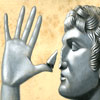Physical Karma

“Hurt not others in ways that you yourself would find hurtful.” – Buddha
“He that leadeth into captivity shall go into captivity: he that killeth with the sword must be killed with the sword.” – Jesus of Nazereth
by Gina Cerminara
On Physical Karma – According to the Edgar Cayce Readings:
The lame, the deaf, the deformed, the blind, the incurable—these are perhaps the most conspicuous examples of human suffering. When we see such an affliction in another, we are moved to pity of the deepest kind. When we experience such an affliction ourselves, and know its sad frustrations, we begin bitterly to question the ways of God to man. Why has this thing happened to me? we ask plaintively. Why has it happened to me?
The belief that suffering must be due to wrongdoing of some kind has been discarded by the modern mind as a superstition of outworn religions; few people nowadays are inclined to think of suffering in terms of “sin”. Yet in the view of the Cayce readings, sin and suffering have an exact cause-and-effect relationship, even though the point of origin of the sin may be hidden from view.
In order to understand this idea, which is basic to the Cayce readings, it is essential to know the meaning of the word karma because this word is the only one that expresses the sin-suffering causal relationship. Karma is a Sanskrit word literally meaning action; in philosophic thought, however, it has come to mean the law of cause and effect, or action and reaction, to which all human conduct is subject. Emerson, who was steeped in the Brahmic philosophy of India, referred to this concept as the law of compensation. Christ formulated it very concisely when he said, “Whatsoever a man soweth, that shall he also reap.” Newton’s third law of motion, namely that every action has its reaction which is equal and opposite, applies as much to the moral law as to the law of physics.
The Cayce life readings are fascinating by virtue of the fact that they trace human afflictions and limitations of the present to specific conduct in the past and thus bring the abstract notion of karma into sharper and more immediate focus. A thorough examination of these cases indicates that there are various types of karma. One type might well be called Boomerang Karma because, like the Australian boomerang, which when thrown returns to the thrower, a harmful action directed toward another person seems to rebound to the perpetrator of the action.
There are many instances of this type of karma in the Cayce files. One example, a college professor who had been born totally blind, heard about Cayce on a radio program called “Miracles of the Mind”. He applied for a physical reading and experienced conspicuous improvement in health and vision by following its instructions, which included osteopathic adjustments, electrical treatments, and a change of diet. Within three months he had achieved 10 percent vision in his left eye, which had been considered hopeless by eye specialists. The professor’s life reading outlined four previous incarnations: one in America during the Civil War period, one in France during the Crusades, one in Persia about 1000 B.C., and one in Atlantis, just before its final submergence.
It was in Persia that he had set in motion the spiritual law which resulted in his blindness in the present. He had been a member of a barbaric tribe whose custom was to blind its enemies with rad-hot irons, and it had been his office to do the blinding.
The question inevitably arises here: How can an individual be held morally responsible for a duty imposed on him by the customs of the society in which he lives? This is a thoroughly valid question.
The second example worthy of note is that of a girl who earned her living as a manicurist and who had been afflicted with infantile paralysis at the age of one year. She was left with both legs crippled and both feet stunted in size, to such a degree that she had to use crutches and braces.
The karmic cause of her condition was attributed to an Atlantean incarnation in which through some means—whether through drugs or hypnosis or telepathy the reading does not specify—she made people “weak in limb and unable to do other than follow. . . .Thus we find the entity meeting itself in that very thing which it brought to others.” (“The entity” is the term used by the readings to refer to the immortal individual who, for the sake of gaining experience on its path to perfection, incarnates again and again.)
A third interesting example of Boomerang Karma is found in the case of a woman of forty who since childhood had suffered from symptoms which had been most recently diagnosed as allergies. When she ate certain foods—principally bread and all cereal grains—she began to sneeze, as if the victim of hay fever. When she came in contact with certain materials—mainly shoe leather and plastic rims of glasses—she experienced excruciating neuritic pains in her left side. She had consulted innumerable doctors over the years, but the only relief she had ever had, she stated, resulted from hypnotic treatments when she was twenty-five. The relief lasted for six years; then the symptoms gradually returned.
This woman’s primary concern in obtaining a Cayce reading was to achieve a cure; but the Cayce clairvoyance included the karmic origin of her condition. “In another experience,” the reading relates, “we find that this entity was a chemist, and used many of these things for the producing of itching in others. She therefore finds it in herself in the present. . . .The entity also used certain substances that caused the breath itself to be poisonous to others. Similarly, the entity now finds itself immediately poisoned in the presence of certain metals, plastics, odors, and leathers. If these leathers are tanned with oak, they do not harm the body. If they are tanned with the very same things that the entity once used to hinder someone else, they hinder the entity.”
A second type of karma in the physical realm might be called Organismic Karma. It involves the misuse of the organism in one life, and results in an appropriate retribution arising from the organism in a succeeding life. A good example of this type of karma is to be seen in the case of a man of thirty-five who since infancy has suffered from digestive weakness. He needs constantly to limit himself to certain foods in certain combinations; yet even after taking these precautions, he requires several hours to digest a meal. Because of this sensitivity, he frequently experiences inconveniences and social embarrassment.
The origin of his disability was attributed by the Cayce reading to an incarnation in the court of Louis XIII of France, when he had been a kind of escort and protector of the king, and an adviser on the king’s wardrobe. His duties he had performed faithfully and well; however, he had one serious weakness—the weakness of gluttony. Even in a preceding life as a court physician in Persia he had been given to the pleasures of the table. Thus for two lifetimes he had committed the psychological sin of excess; the imbalance needed somehow to be equalized, and thus we find him forced, through predisposed bodily weakness, to become temperate in the present.
A third type of physical karma which is frequently found in the Cayce readings might be given the name Symbolic Karma. This is perhaps the most surprising and most interesting type of karmic consequence among the physical cases.
One of the early life readings was given for a young man who suffered since early childhood from anemia. His father was a physician, and the boy had been given every known treatment for his condition, but to no avail. A malfunction which so stubbornly resists cure is highly suggestive of a deep-seated karmic cause. And, in fact, the life reading traced the condition to an incarnation in Peru, five lifetimes back, where the entity had ruthlessly seized control of the country, thereby becoming its ruler. “Much blood was shed,” says the reading: “hence anemia in the present.”
The significance of this phrase becomes fully apparent only when we compare the case with other examples of physical karma. It is clearly not a case of Organismic Karma, since the man’s sin had not been that of misusing his own body through intemperances of any kind. It is not strictly speaking an example of Boomerang Karma either; for had it been this type, the young man would have been the victim, in battle, of a ruthless conqueror’s slaughter—perhaps a young Pole, whose blood was shed by Hitler’s troops.
Instead, we see that his own body became the field of slaughter; it became, as it were, the sacrificial altar on which his crime was expiated. This lifelong bodily deficiency constitutes a far more protracted form of educative justice than bloody death on a battlefield could possibly have accomplished. The entity once shed the blood of a people for whom he felt a conqueror’s contempt; now he himself is a weakling, by virtue of his own bloodstream deficiency, and thus one part of his body has taken over his karma symbolically.
Here are a few typical examples of the many instances of such symbolic retribution in the Cayce files. In a severe case of asthma, the sufferer was told: “You cannot press the life out of others without seeming at times to have it pressed out of oneself.” A person who was deaf was admonished: “Then do not close your ears again to those who plead for aid.” (This entity had been a nobleman at the time of the French Revolution.) A sufferer with tuberculosis of the spine was informed: “The entity thwarted others and is meeting it now in himself.” A victim of progressive muscular atrophy learned that: “This is not merely the atrophy of the nerves and muscles of the lower limbs; it is the result of what you built in your life and the life of others in other experiences.”
Perhaps the most striking case of Symbolic Karma in the files is that of a young boy of eleven who had been a chronic bed-wetter since the age of two. The case is worth discussing at some length because of the rather unusual nature of the boy’s cure.
As a baby, he was a very quiet child; he gave his parents no difficulty until the time of the birth of a second child, when he began to wet his bed during the night. This became a regular nightly occurrence. Both parents were aware of the fact that the first child may feel insecure at the time of the birth of another, and frequently revert to infantile habits for the sake of regaining attention and supremacy. Every effort was made to show the boy that he has not been replaced in their affections by the baby sister, but the bed-wetting continued.
Finally, when the boy was three, the parents decided to consult a psychiatrist. For over a year, he was under psychiatric care; when the parents saw that the condition would not yield even to psychiatry, the treatment was discontinued. For five years thereafter the boy continued to wet the bed every night. The parents consulted every known specialist, tried every known treatment—all to no avail. At the age of eight the childish habit still persisted. Once again the parents decided to seek the help of a psychiatrist. There followed two more years of treatment which proved helpful to his general personality growth, but the condition continued. In his tenth year, after two years of fruitless trial, psychiatric treatment was abandoned.
When the boy was eleven, the parents heard of the work of Edgar Cayce, and the father determined to obtain a reading on the peculiar case of his son. According to the boy’s life reading, in the life previous to the present he had been a minister of the gospel in the early Puritan days, at the time of the witchcraft trials; he had been active in punishing supposed witches by dunking them, on a stool, into a pond.
This karmic explanation given, the reading held out definite hope for a cure. The parents were told to use suggestion on the boy before he went to sleep at night; the implication was that the suggestion should be of a spiritual rather than a physical nature.
Soon after obtaining the reading, the mother sat by the boy’s bedside one night, and waited until he was about to drop off to sleep. She then began to repeat these words, in a slow, monotonous voice: “You are good and kind. You are going to make many people happy. You are going to help everyone with whom you come in contact. . . .You are good and kind. . . .” The same idea was expressed in various forms for perhaps five or ten minutes to the now sleeping boy.
That night, for the first time in almost nine years, the boy did not wet the bed. For several months the mother continued the suggestions, always in the same vein; not once, in that period, did the condition recur. Gradually she found it possible to give the suggestion only once a week; and finally not even that was necessary. The boy was completely cured.
The boy has since become well adjusted; he is well liked, popular, a good student, and a leader. The initial introversion of his nature has been so well modified that on a Johnson O’Connor Human Engineering Laboratory test he was rated as a perfectly well-adjusted extrovert. For this change in personality the mother feels that the credit should be given in part to the psychiatric treatment, in part to the Cayce reading.
Now, at the age of sixteen, one of the boy’s marked characteristics, according to the observation of both parents, is a great tolerance of other people. For any defect of character in other people he finds some psychological explanation, some justification, It would seem, therefore, that the intolerance of which his physical disability was symbolic self-chastisement had been transmuted into an active tolerance. The equilibrium has been so thoroughly reestablished that the physical karma could justly be withdrawn.
Excerpt from Many Mansions
Posted in Past Life Therapy, Reincarnationwith comments disabled.





